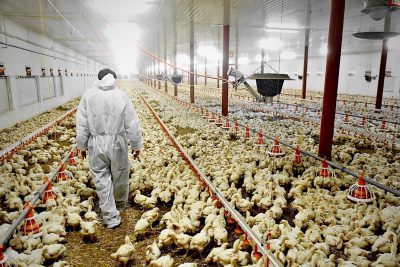At some point in your life, you’ve probably been prescribed a course of antibiotics to treat a bacterial infection. Most of us take it for granted that the antibiotics will work, and we can move on with our busy lives. But, there is a lurking danger, and the cause may surprise you: Antibiotic overuse leads to the rise of superbugs.
Antibiotics are wonder drugs that stop infections by killing bacteria or keeping bacteria from reproducing. Prior to the discovery of penicillin by Alexander Fleming in 1928, there were no effective treatments for a number of bacterial infections. Fleming and his petri dish heralded one of the greatest advancements in medicine: antibiotics. This meant that infections that once killed people were now treatable.
The meat industry, which raises and kills nine billion animals annually in the U.S., has also discovered the usefulness of antibiotics to deal with a persistent problem: how to keep large numbers of animals healthy and stimulate their growth, when they are raised in massive industrial facilities, called concentrated animal feeding operations, or CAFOS.
Superbugs Love Factory Farms
The animals raised in CAFOs are crammed together indoors; food and water are brought to them, and they live in an unsanitary environment that includes their own waste. They are never allowed outdoors to graze or roam. These conditions cause great physical and emotional stress for the animals, and they get sick. The solution is to feed the animals subtherapeutic doses of antibiotics on a daily basis, in order to keep them healthy enough to make it to slaughter, and to stimulate quick growth on less food. The use of antibiotics has become a standard practice in CAFOs. As of 2016, around 69% of all medically important antibiotics in the nation were sold to be fed to farmed animals.
The CAFO industry solved one problem, but created another. Exposing animals to daily doses of antibiotics has been found to create antibiotic-resistant bacteria. Urvashi Rangan, Ph.D., executive director of the Food Safety and Sustainability Center at Consumer Reports, describes the process:
“The combination of frequent antibiotic use and the conditions the animals are raised in creates a hospitable environment for superbugs to develop and proliferate,” Rangan says. The drugs “can kill off weaker bacteria in the animals’ digestive tracts, leaving a few hardy survivors to multiply. Those bacteria, as well as certain antibiotic residues, are excreted in manure, which is the perfect medium for antibiotic-resistant bacteria to grow. Over time, you wind up with colonies of almost indestructible superbugs.”
Superbugs Threaten Us All
Superbugs? That scary sounding word is used to describe deadly pathogens that are not treatable using the current array of antibiotics. According to the U.S. Department of Health and Human Services, Centers for Disease Control and Prevention (CDC):
“Antimicrobial resistance is one of our most serious health threats. Infections from resistant bacteria are now too common, and some pathogens have even become resistant to multiple types or classes of antibiotics (antimicrobials used to treat bacterial infections). The loss of effective antibiotics will undermine our ability to fight infectious diseases and manage the infectious complications common in vulnerable patients undergoing chemotherapy for cancer, dialysis for renal failure, and surgery, especially organ transplantation, for which the ability to treat secondary infections is crucial.”
how big a problem is antibiotic resistance?
The CDC has estimated that, on an annual basis, at least two million Americans are experiencing infections that are resistant to antibiotics; over 23,000 people are dying because the antibiotics relied on are not working.
The animal farming industry claims that these fears are exaggerated but, the evidence seems to negate that claim. A 2018 study published by the World Health Organization (WHO) confirmed “the serious situation of antibiotic resistance worldwide.” It said: “Some of the world’s most common—and potentially most dangerous—infections are proving drug-resistant.”
The federal Food and Drug Administration (FDA), which has dragged its feet for decades, is finally taking steps to place tighter restrictions on antibiotic use, and no longer allows the use of drugs medically important to humans to be used on CAFOs. A new regulation requires that a licensed veterinarian authorize the use of antibiotics in farmed animals, and only to treat animals according to the drug’s label. But, there are loopholes.
Is the health threat over? It’s too early to tell, but given the government’s reluctance to regulate effectively, and the industry’s resistance to changing its practices, we should continue to have serious concerns.
By Joyce Tischler, Professor of Practice, Animal Law, Center for Animal Law Studies at Lewis & Clark Law School



